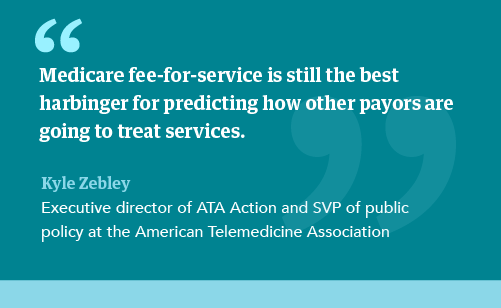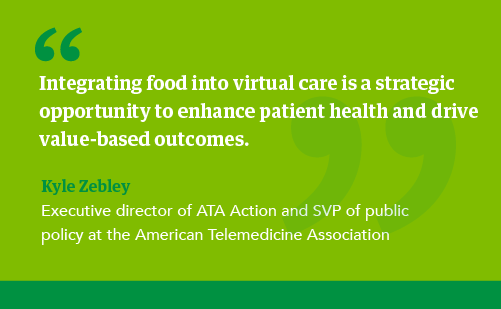
From generative AI to remotely delivered digital therapeutics, telehealth is evolving toward more predictive, personalized, and data-driven care. However, regulatory uncertainty threatens to slow this innovation. Here are seven trends popping up in the telehealth space in 2025.
1. Regulatory uncertainty continues
Technological innovation continues to unlock new telehealth possibilities, but regulatory uncertainty — and, to a lesser extent, reimbursements — threaten to hobble its growth. The lack of predictable policy from the federal government, combined with the variability of state regulations, continues to cause confusion.
Instability in federal policy
The lack of a permanent federal telehealth policy remains the biggest obstacle to long-term investment and innovation, warns Kyle Zebley, executive director of ATA Action and SVP of public policy at the American Telemedicine Association (ATA).

Despite bipartisan support, federal action has resulted only in temporary extensions of key provisions, keeping the industry in a perpetual state of uncertainty.
As of May 7, 2025, Congress has extended core Medicare telehealth provisions and the Acute Hospital Care at Home program through Sept. 30, 2025. These extensions preserve expanded originating site definitions, broaden provider eligibility, and maintain telehealth access for Federally Qualified Health Centers and Rural Health Centers.
However, other provisions have lapsed, such as first-dollar coverage for high-deductible health plans and expanded in-home cardiopulmonary rehab.
A patchwork of states
State policy remains a patchwork. Despite momentum toward greater flexibility and interstate practice, states still differ significantly when it comes to licensing, reimbursement, and covered services.
The growth of interstate compacts is encouraging, but Zebley says a uniform national telehealth framework remains elusive. As of May 2025, the Interstate Medical Licensure Compact Commission includes 41 states, the District of Columbia, and Guam. Legislation is pending in four more states.
In addition, although 43 states now have some form of telehealth parity law, most of these laws ensure coverage parity, not payment parity. This can leave providers with inconsistent reimbursement rates and added financial unpredictability. (The Center for Connected Health Policy regularly updates its map of telehealth parity laws.)
Stay up-to-date: 2025 Telehealth regulations and resources
2. AI drives telehealth innovation
AI has long been involved in telehealth, supporting predictive modeling, clinical decision-making, and population health strategies. It has also helped organizations streamline clinical and administrative operations.
What’s new, says Zebley, is the rapid adoption of generative AI in telehealth, especially for clinical documentation and data summarization. Generative AI involves far more than mere transcription. With patient consent, it can listen to provider-patient conversations, generate clinical notes, and summarize key takeaways in real time, significantly reducing administrative burdens and freeing clinicians to focus more on care.
Use AI in your healthcare staffing plan: A guide to using AI to enhance the physician recruiting process
3. RPM turns data into actionable information
AI also continues to transform another telehealth function: remote patient monitoring (RPM).
RPM is already well established, especially for chronic conditions like diabetes, hypertension, and heart failure. Now, AI-powered analytics can transform data from wearables into actionable insights —detecting patterns, flagging risks, and prompting timely, personalized interventions.
By integrating RPM with AI and interoperable tools, healthcare organizations can shift care from reactive to proactive, reducing hospital readmissions and emergency visits, thereby improving patient and financial outcomes.
Looking ahead, this integration of AI and RPM will support greater precision and personalization. Here are three examples:
Mental health: Behavioral healthcare providers were early adopters of virtual visits. Today, AI-powered wearables and apps track behavioral patterns to detect early signs of depression and anxiety relapses. Soon, clinicians may deliver interventions such as personalized biofeedback therapy through wearables.
Cardiology: AI-enabled monitoring uses wearables to capture cardiac data while patients go about their lives, capturing even the most subtle cardiac anomalies. Clinicians can intervene before those anomalies become serious conditions or emergency cardiac events. Such monitoring reduces hospitalizations and can improve post-discharge care, avoiding unnecessary readmissions.
Diabetes: AI integrated with continuous glucose monitoring (CGM) systems enables real-time analysis of glucose levels. CGM paired with insulin pumps can automate insulin delivery based on continuous feedback. Emerging research suggests that integrating AI, CGM, and transcutaneous auricular vagus nerve stimulation (taVNS) may improve glucose regulation through noninvasive neuromodulation.
RPM continues to become more sophisticated, but reimbursement remains a major barrier to broader adoption. Current Medicare fee-for-service rates are simply too low to support robust deployment, which is troubling, says Zebley. “Medicare fee-for-service is still the best harbinger for predicting how other payers are going to treat services,” he says.

4. Expanding into digital therapeutics
The ability to deliver therapeutics directly to a patient remotely illustrates the broader shift toward digital therapeutics (DTx) — personalized, tech-driven care based on continuous monitoring.
DTx initially focused on mental health and chronic disease management. Today, developers and researchers are refining these interventions and bringing new digital therapies to market. They’re also exploring the use of DTx in other indications, including oncology.
As always, safety and security are key concerns. Last year, the Digital Therapeutics Alliance (recently acquired by ATA Action) partnered with DirectTrust to develop criteria for a digital therapeutics accreditation program. The criteria will focus on safety, transparency, privacy protections, and compliance with interoperability regulations and best practices.
5. Integrating food and telehealth
Nonprofits, public health professionals, and healthcare providers have long advocated for food as medicine, calling for the integration of nutritious food into healthcare delivery to improve patient health outcomes. Telehealth moves this forward.
Virtual care platforms now offer patients remote access to nutritional counseling, food security screenings, and personalized dietary plans. Telehealth enables referrals to food banks, nutrition programs, and food-as-medicine initiatives such as produce prescriptions and medically tailored meal deliveries.
With remote monitoring tools, clinicians can track patients’ dietary habits and key health markers over time. Integrated virtual platforms allow multidisciplinary teams—including dietitians, physicians, and social workers—to collaborate more effectively.
ATA Action recently launched the Virtual Foodcare Coalition to support these efforts, which advocates for policy and reimbursement models that support virtual food and nutrition interventions. Integrating food into virtual care is a strategic opportunity to enhance patient health and drive value-based outcomes, Zebley says.

6. DTC niche services
Direct-to-consumer (DTC) and cash-pay telehealth models, especially in niche areas such as sexual health and weight management, continue to grow dramatically. These services often bypass payor reimbursement models while offering convenience and privacy.
One standout example is the demand for GLP-1 weight loss medications, which has driven a surge in telehealth startups focused on obesity treatment. “We’re seeing an explosion of these offerings—some covered by payors, others marketed directly to patients,” Zebley notes.
7. More workforce solutions
Telehealth expands a healthcare organization’s reach, mitigating geographic barriers and helping balance supply and demand for medical professionals. It’s an essential component of any solution to workforce shortages, particularly for underserved and rural communities, says Zebley.
Along those same lines, telehealth provides physicians flexibility, which can mitigate burnout.
None of this is new, but the convergence of innovative telehealth technology and growing clinician shortages make using telehealth to optimize staffing an ongoing strategic priority.
Create a stable workforce: How flexible physician staffing can improve your staffing challenges
Keep moving forward
Telehealth and digital health are moving beyond traditional care delivery. Advances in generative AI, digital therapeutics, remote monitoring, and food-as-medicine strategies are transforming telehealth, making it more precise, personalized, and predictive.
But progress depends on more than just innovation. Policy and payment must evolve as well.
Zebley urges leaders to assess their organization’s digital health maturity and act now to avoid falling behind. That means investing in scalable technology, staying informed on policy, ensuring compliance, and — critically — engaging in advocacy.
Telehealth’s future will be shaped by those who show up, he says. “Standing still is not an option.”
Interested in learning more about staffing your telehealth program with locum tenens providers? Give us a call at 866.588.5996 or email ecs.contact@chghealthcare.com.